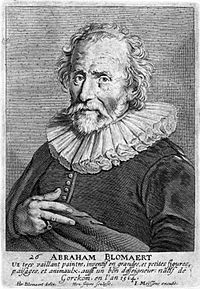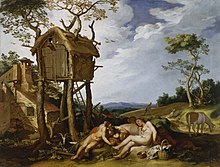Abraham Bloemaert
| Abraham Bloemaert | |
|---|---|
 'Abraham Bloemaert i Het Gulden Cabinet, p 45 | |
| Personlig information | |
| Født | 25. december 1564 Gorinchem, Forenede Nederlande (nuværende Holland) |
| Død | 1. marts 1651 (87 år) Utrecht, Forenede Nederlande |
| Nationalitet | Hollandsk |
| Uddannelse og virke | |
| Felt | Maler, grafiker |
| Uddannelsessted | Hieronymus Francken, mm. |
| Periode | Nordisk mannerisme , Barok |
| Nomineringer og priser | |
| Udmærkelser | . |
| Information med symbolet | |
Abraham Bloemaert (25. december 1564 – 27. januar 1651) var en hollandsk kunstmaler og grafiker med speciale i kobberstik. Han tilhørte den nordiske manierisme-bevægelse fra omkring 1585, men tilpassede sin stil til de nye barokke strømninger. Han malede historiske-, mytologiske-, og bibelske motiver og landskabsmalerier.
Bloemaert var født i Gorinchem som søn af arkitekt og billedhuggeren Cornelis Bloemaert, som flyttede med sin familie til Utrecht i 1575, hvor Bloemaert blev oplært af sin far og Gerrit Splinter (som selv var oplært af Frans Floris) og Joos de Beer.[1] (ifølge Mander lærte han ikke synderligt af dem). I 1581-1583 opholdt han sig tre år i Paris, hvor han studerede under Jehan Bassot (måske Jean Cousin den yngre) og en Maistre Herry.[1] Mens han opholdt sig i Fontainebleau, modtog han yderligere oplæring fra sin landsmand Hieronymus Francken.[1] Han vendte tilbage til Utrecht i 1583 umiddelbart før den franske Hugenottkrig, under hvilken store dele af Château de Fontainebleau blev ødelagt. Da hans far blev udnævnt til stadsbygmester (Stads-bouwmeester) i 1591, fulgte Abraham ham dertil, og efter farens død i 1593 vendte han tilbage til Utrecht, hvor han grundlagde et værksted og blev medlem af Utrechts Sankt Lukasgilde (traditionelt kaldet "zadelaarsgilde") i 1594.
I 1611 var han og Paulus Moreelse blandt grundlæggerne af et ny Sankt Lukasgilde i Utrecht. Mange af Bloemaerts malerier blev bestilt af Utrechts katolske schuilkerk[2]
Bloemaert drev tydeligvis en succesrig forretning, for i 1671 havde han midler til at købe et stort hus i Mariakerkhof i centrum for det katolske samfund i Utrecht. Men i modsætning til den protestantiske Moreelse – og på trods af sin velstand – blandede Bloemaert sig aldrig i politik. Han deltog derimod i det intellektuelle liv i Utrecht og havde flere venner herfra som antikvaren Aernout van Buchel. I 1626 fik hans værksted besøg af Elizabeth Stuart, tidligere dronning af Bøhmen, og året efter af Peter Paul Rubens.
Han var en begavet lærer. Iblandt hans mange elever var hans fire sønner Hendrick, Frederik, Cornelis og Adriaan, som alle nåede et betydeligt ry som kunstnere foruden Jan van Bijlert, Andries Both, Gerard van Honthorst, Leonaert Bramer, Bartholomeus Breenbergh, Hendrick ter Brugghen, Jacob Gerritsz. Cuyp, Willem van Drielenburg, Wybrand de Geest, Nikolaus Knüpfer, Cornelius van Poelenburgh, Henrik Schook, Matthias Stom, Herman van Swanevelt, Dirck Voorst og Jan Weenix.
Abraham Bloemaert var gift to gange. Første gang i 1592 med Judith van Schonenburch fra Utrecht. Hun døde barnløs i 1599. I 1600 giftede han sig igen, denne gang med Gerarda de Roij, som fødte ham mindst otte børn; mindst fire sønner blev kunstnere. Abraham Bloemaert døde i Utrecht og ligger begravet i St.-Katharinen-Kathedralen der.
Offentlig udstillet
Bloemaert er repræsenteret i de følgende samlinger: Detroit Institute of Arts, Michigan; Fine Arts Museums of San Francisco; Ermitagen, Skt. Petersborg; Indianapolis Museum of Art, Indiana; J. Paul Getty Museum, Los Angeles; Mauritshuis, Haag; Metropolitan Museum of Art, New York; Minneapolis Institute of Arts, Minnesota; Museum of Fine Arts, Boston; National Gallery of Canada, Ottawa; Rijksmuseum, Amsterdam; Royal Academy of Arts, London; University of Rochester, New York; Bob Jones University, Greenville, South Carolina; Centraal Museum, Utrecht; Cleveland Museum of Art, Ohio; Courtauld Institute of Art, London; Harvard University Art Museums, Massachusetts; Kunsthalle zu Kiel i Tyskland mm.
Gallery
Johannes Døberen prædiker, c. 1620
Gudernes fest ved Peleus og Thetis bryllup, 1638 (Mauritshuis, 17)
Noter
- ^ a b c Abraham Bloemaert i Karel van Manders Schilderboeck, 1604, Digital library for Dutch literature (nederlandsk/hollandsk)
- ^ "The Artist's Religion: Paintings Commissioned for Clandestine Catholic Churches in the Northern Netherlands, 1600-1800," Xander van Eck, Simiolus: Netherlands Quarterly for the History of Art, Vol. 27, No. 1/2 (1999), pp. 70-94. (engelsk)
|
Medier brugt på denne side
In this parable from the Gospel of Matthew, the devil, identified by his horns and tail, sows weeds (or tares) in the field where wheat has been planted, while the lazy peasants are sleeping. Christians considered sloth one of the Seven Deadly Sins to which mankind was subject as a result of the Original Sin of Adam and Eve, to whom the two naked sleepers allude. The dovecote (a birdhouse to attract doves or pigeons that can be trapped for food without the bother of raising them) was associated with the morally lazy who take the easy way. The goat, known for its lust, alludes to self-indulgence, and the peacock, to pride. Bloemaert was gifted in depicting natural detail, but he never painted pure landscapes, preferring pictures with a lesson. He was one of the leading artists of Utrecht and trained many major artists of the next generation.
The four evangelists traditionally appeared alone, but in 1526, Albrecht Dürer showed two groups of two evangelists, and about 1566, Frans Floris showed all four together. Other artists followed suit. Bloemaert’s student Hendrick Terbruggen (1588–1629) and Peter Paul Rubens prolonged the theme, but it disappeared after 1621.
Here the Utrecht painter attempts to unify the evangelists and their symbols in a logical, horizontal composition. Luke with his ox, Mark with his lion, John with his eagle, and Matthew with his angel are gathered around a table, each figure intently writing his Gospel. Mark’s lion peeks out from underneath a heavy carpet. Bloemaert boldly poses Matthew with his back toward the viewer, perhaps to convey an impression of an uncontrived gathering of figures in a realistic setting. The scene is set in a shallow space, but the vibrant coloring of the figures, the angularity of their poses, and the frontal lighting give the composition a feeling of depth. Various naturally observed details stand out, such as the broken rush seat of Matthew’s humble chair and Luke’s ox, which gazes out from this learned gathering. The patron saint of artists and doctors, Luke is shown with the tools of these professions, including the artist’s palette and the doctor’s bottle for urine samples, and he is writing the Gospel in Greek characters. One of the folio volumes at his feet bears Bloemaert’s signature on the spine.
Utrecht was a Catholic stronghold, and Bloemaert, a practicing Catholic, was a founding member of its painter’s guild in 1611; he had patrons in both the Northern and the Southern Netherlands. The location for which this painting was commissioned has not been identified. The subject of the four evangelists appealed to both Catholics and Protestants, so it might have been a "safe" subject for a Northern Netherlandish Catholic church.Portrait of Abraham Bloemaert (1564/66 - 1651) by his son Hendrick.




















